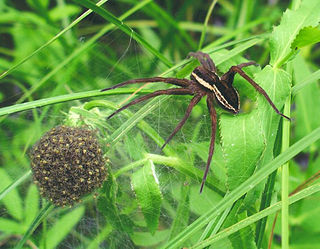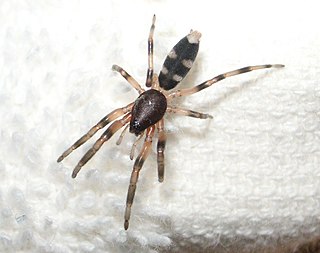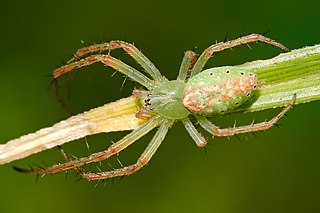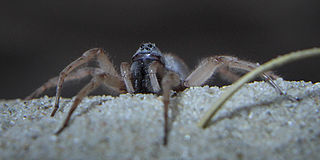
The Thomisidae are a family of spiders, including about 175 genera and over 2,100 species. The common name crab spider is often linked to species in this family, but is also applied loosely to many other families of spiders. Many members of this family are also known as flower spiders or flower crab spiders.

Dolomedes is a genus of large spiders of the family Pisauridae. They are also known as fishing spiders, raft spiders, dock spiders or wharf spiders. Almost all Dolomedes species are semiaquatic, with the exception of the tree-dwelling D. albineus of the southeastern United States. Many species have a striking pale stripe down each side of the body.
Embrik Strand was an entomologist and arachnologist who classified many insect and spider species including the greenbottle blue tarantula.
Opisthoncana is a monotypic genus of jumping spiders containing the single species, Opisthoncana formidabilis. It was first described by Embrik Strand in 1913, and is only found on New Ireland. The name is a variation of the salticid genus Opisthoncus.

Lamponidae is a family of spiders first described by Eugène Simon in 1893. It contains about 200 described species in 23 genera, most of which are endemic to Australia, with the genus Centrocalia endemic to New Caledonia, and two Lampona species also occurring in New Zealand where it is commonly known as the "White Tail" spider. Lampona papua is endemic to New Guinea, where two otherwise Australian species also occur.

Agelena is a genus of agelenid spiders first described by Charles Athanase Walckenaer in 1805. Sometimes referred to as Eurasian grass spiders, they trap their prey by weaving entangling non-sticky funnel webs. They are limited to the Old world, occurring from Africa to Japan.

Badumna is a genus of intertidal spiders that was first described by Tamerlan Thorell in 1890. They are harmless spiders that can be found around human structures and buildings. They are darkly colored, usually with a lighter colored pattern on the abdomen. The most well-known species is B. insignis, also known as the "black house spider" or "black window spider".

Cyrtophora, the tent-web spiders, is a genus of orb-weaver spiders first described by Eugène Simon in 1895. Although they are in the "orb weaver" family, they do not build orb webs. Their tent-like, highly complex non-sticky web is sometimes considered a precursor of the simplified orb web. These webs are aligned horizontally, with a network of supporting threads above them. These spiders often live in colonies. Females have a body length of mostly about 10 millimetres (0.39 in) long. Some members, including Cyrtophora cicatrosa, exhibit the ability to change colour rapidly.

Thomisus is a genus of crab spiders with around 150 species described. The genus includes species that vary widely in their ecology, with some that ambush predators that feed on insects visiting flowers. Like several other genera in the family Thomisidae, they are sometimes referred to as flower crab spiders, from their crab-like motion and their way of holding their front legs, reminiscent of a crab spreading its claws as a threat.

Allocosa is a spider genus of the wolf spider family, Lycosidae. The 130 or more recognized species are spread worldwide.

Pirata is a genus of wolf spiders, commonly known as pirate wolf spiders.
Mistaria fagei is a species of spider in the family Agelenidae. It is native to Kenya. It was first described by Caporiacco in 1949 as Agelena fagei, and transferred to the genus Mistaria in 2018.

Bassaniana, commonly called bark crab spiders, is a widespread genus of crab spiders that was first described by Embrik Strand in 1928.

Sidymella is a genus of spider in the family Thomisidae, found in South America, Australia and New Zealand. It was originally named Sidyma, but this was later found to have been used already for a genus of moths.
Mistaria is a genus of funnel weavers first described by Pekka T. Lehtinen in 1967.
Lamponina is a genus of Australian white tailed spiders that was first described by Embrik Strand in 1913.
Aethrodiscus is a genus of African orb-weaver spiders containing the single species, Aethrodiscus transversalis. It was first described by Embrik Strand in 1913, and has only been found in Central Africa.

Geolycosa is a genus of wolf spiders first described in 1904.
Labullula is a monotypic genus of African dwarf spiders containing the single species, Labullula annulipes. It was first described by Embrik Strand in 1913, and has only been found in Angola, Cameroon, and Comoros.
Oreonetides is a genus of dwarf spiders that was first described by Embrik Strand in 1901.











